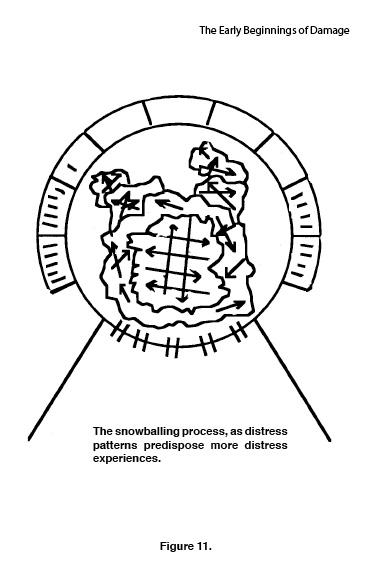CHAPTER XIII: The Early Beginnings of Damage
Each of us, of course, meets hurt experiences very early in his/her life. Our physical weakness, lack of experience and information and the resulting extreme dependence on others when we are very young leave us wide open to be hurt repeatedly in this period.
These early hurts may be inflicted by many things. Bumps and bruises and accidents and cold and hun ger and frustration can all play their part.
In our civilization, however, the dominant source of hurts when we are very young is precisely the distress patterns of the adults around us. For an adult to be have irrationally is upsetting to a baby; and when that irrationality consists of or is accompanied by cross ness, reproach, invalidation, ridicule, aloofness or vio lence as it usually is, the hurt is severe.
Perhaps you can imagine an infant playing happily with her mother. She is warm, happy, outgoing, lov ing towards her. The mother is warm, happy, outgo ing, loving to her baby. The world is a wonderful place.
Then the phone rings and the mother goes to an swer it. Baby waits for the wonderful play to resume. She has no way of knowing what signals come to her mother over the phone, nor of understanding their ef fect if she did know. So it can happen when the mother returns and baby stretches her arms to her warmly and lovingly, she is met with an expression of disgust and a loud, harsh voice saying “Don’t bother me!” in tones of hate.
Sounds coming over the phone have triggered an old distress recording in the mother, which takes over and “plays” itself at the baby through her. The source of the recording has nothing to do with the baby or the mother’s relation to her. Baby, however, is hurt, and a recording etches itself as she stops thinking and the experience mis-stores.
Whatever distress the experience contains will re main rigidly attached to the entire experience and to any experience which “reminds” the baby of it later. This rigid effect will vary greatly with each infant, depending on details and especially on what earlier distress patterns already exist to be re-stimulated by this one.
One infant in a situation like the above may be left with a fixed distrust of all other people. Another may be left with a rigid sense of his/her being a “bother.”
In any case, the “tracks” of this kind of early expe rience will show, with great effect, among the rigidi ties of the adult into which the infant grows. The adult, in his/her first interview with a counselor, is likely to volunteer that he/she “is a nuisance," that he/she wants help to quit being “such a bother to everybody.” A host of later distress and/or re-stimu lation experiences will be related as indicating what a “bother” he/she is, but eventually, as his/her coun seling progresses, the effect of the early experience will emerge as the significant “direction-fixer” it has been.
We are hurt early and often, primarily by the dis tress patterns of the adults in whose charge we are. These early hurts are re-stimulated and added to at an increasing rate, becoming chronic and “numb” (i.e., seeming to become calloused) in some areas, but al ways continuing to clog our thinking abilities at an increasing rate. (Fig. 11)

This is the bad side of “growing up.” This process of “ossifying” our flexible intelligence has gone on re lentlessly for all of us.